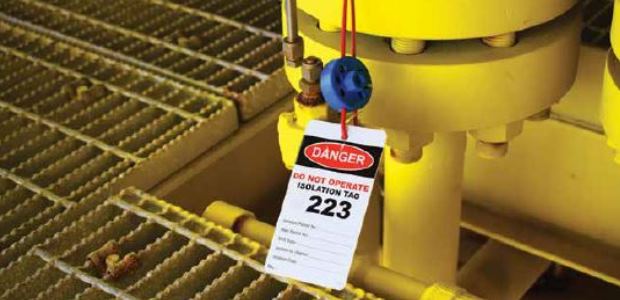
Training Workers on Control of Hazardous Energy
OSHA's lockout/tagout standard, 29 CFR 1910.147, explains exactly why employees must be trained. It also requires different levels of training for three categories of employees.
- By Jerry Laws
- Aug 01, 2018
Failing to train workers on the control of potentially hazardous energy can be an expensive mistake. Earlier this year, in April, OSHA issued a willful citation to a Pennsylvania paperboard manufacturer for alleged violations of 29 CFR 1910.147(c)(7)(i), the section of OSHA's lockout/tagout standard that requires employee training so that they understand the purpose and function of the energy control program and so they acquire the knowledge and skills necessary for the safe application, usage, and removal of the energy controls.
The citation also alleged that the company failed to develop, document, and use procedures for controlling hazardous energy when employees were doing maintenance on four machines, including adjustments, cleaning, replacing parts, and clearing jams.
OSHA said the company had previously been cited for both types of violations in 2014 and 2017, and the agency's proposed penalty for this citation was $71,135.00. The overall proposed penalty: $201,212.00.
"Several violations identified in our 2015 inspection were only partially corrected or continued," Mark Stelmack, director of OSHA's Wilkes-Barre Area Office, said at the time. "The employer's continued failure to follow basic safety standards places employees at risk of serious injury or worse."
Levels of Employee Training
Preventing serious injuries is the point of the lockout/tagout standard and the training requirements in it.
After explaining why employees must be trained, as mentioned above, the standard also specifies different levels of training for the three categories of employees, saying:
- Authorized employees must receive training on recognition of applicable hazardous energy sources, the type and magnitude of the energy available in the workplace, and the methods and means needed for energy isolation and control [29 CFR 1910.147(c)(7)(i)(A)].
- Affected employees must receive training on the purpose and use of the energy control procedure [29 CFR 1910.147(c)(7)(i)(B)].
- Other employees (employees whose work activities are or may be in an area where energy control procedures may be utilized) must be instructed about the procedure and about the prohibition relating to attempts to restart or reenergize machines or equipment that are locked out or tagged out [29 CFR 1910.147(c)(7)(i)(C)].
Removal of Locks and Tags
The standard also spells out what procedures an authorized employee must follow before he or she removes lockout or tagout devices and before energy to the machine is restored. The procedures are:
- Inspection of the machine/equipment: The work area must be inspected to ensure that nonessential items, such as tools or spare parts, have been removed and that all of the machine or equipment components are operationally intact.
- Employees' locations: The work area must be checked to make sure all employees have been safely positioned or have cleared the area. Also, all affected employees must be notified that the lockout or tagout devices have been removed before the equipment is restarted.
- Removal of the lockout or tagout device: Each lockout or tagout device must be removed from the energy-isolating device by the employee who applied it.
When the authorized employee who applied the lockout or tagout device is not available to remove it, the device may be removed under the direction of the employer, provided that specific procedures and training for the removal have been developed, documented, and incorporated into the employer's energy control program, the standard states at 29 CFR 1910.147(e)(3).
But that's not all: The employer must verify that the authorized employee who applied the device is not at the facility; must make all reasonable efforts to contact the authorized employee to inform him or her that the lockout or tagout device has been removed; and must ensure the authorized employee knows the device has been removed before he or she resumes work at the facility.
Retraining and Certification of Employees' Training
Employee retraining is covered in 1910.147(c)(7)(iii)(A).
"Retraining shall be provided for all authorized and affected employees whenever there is a change in their job assignments, a change in machines, equipment or processes that present a new hazard, or when there is a change in the energy control procedures," it states. The following section states that additional retraining must be conducted whenever a periodic inspection reveals, or whenever the employer has reason to believe, that there are deviations from or inadequacies in the employee’s knowledge or use of the energy control procedures.
The retraining is to "reestablish employee proficiency and introduce new or revised control methods and procedures, as necessary," the standard states.
At 1910.147(c)(7)(iv) is the requirements that the employer is to certify that employee training has been accomplished and is being kept up to date, and the certification must include each employee's name and the dates of training.
References
1. https://www.osha.gov/dts/osta/lototraining/tutorial/empl.html
2. https://www.osha.gov/ooc/citations/MidvalePaperboxCo_1268278.pdf
This article originally appeared in the August 2018 issue of Occupational Health & Safety.